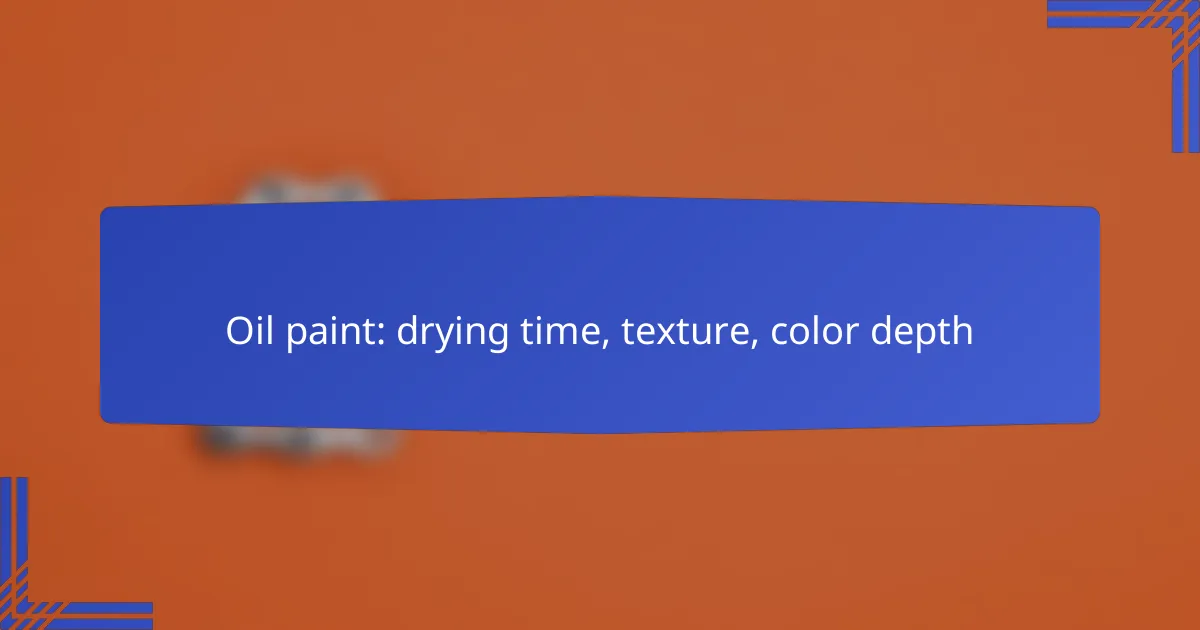Oil paint is renowned for its extended drying time, which can range from several days to weeks, influenced by factors like application thickness and environmental conditions. This slow drying process not only allows for intricate blending and layering but also enables artists to achieve a wide variety of textures, from thick impasto to smooth finishes. Additionally, oil paint’s unique properties contribute to enhanced color depth, resulting in rich, vibrant hues and subtle tonal variations that elevate the visual impact of the artwork.
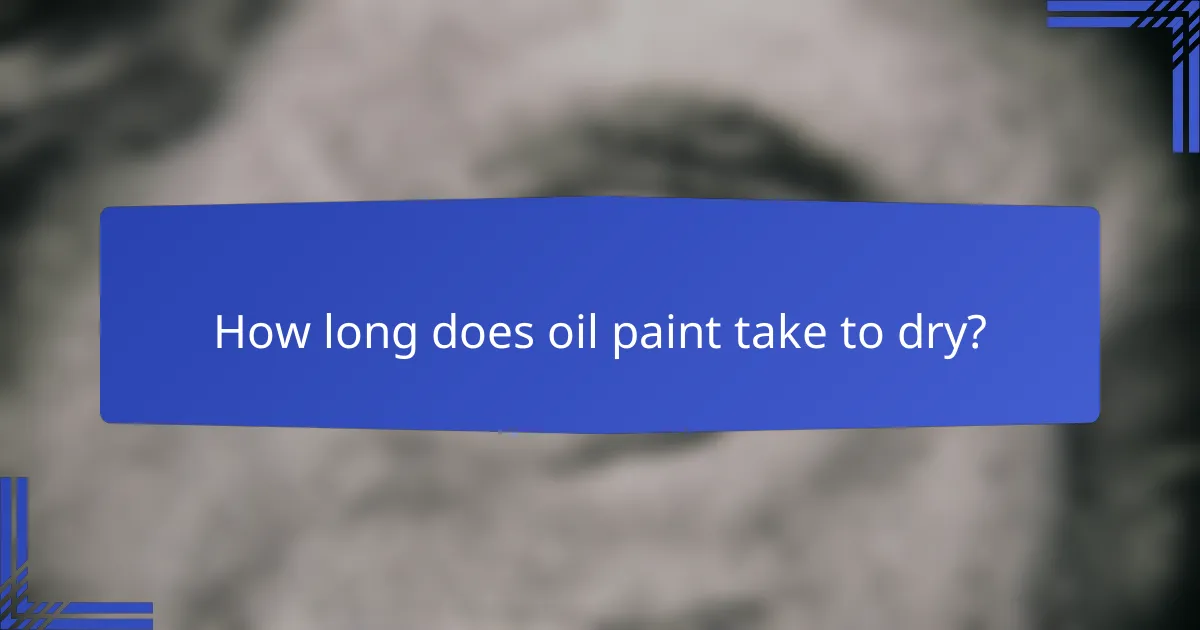
How long does oil paint take to dry?
Oil paint typically takes several days to weeks to dry completely, depending on various factors such as the thickness of the application and environmental conditions. Understanding the drying times for different layers can help artists plan their work effectively.
Drying time for thin layers
Thin layers of oil paint usually dry faster than thicker applications, often within a few days. A common rule of thumb is that a layer less than 1 millimeter thick can become touch-dry in 24 to 48 hours, allowing for quicker layering and adjustments.
However, while the surface may feel dry, the paint underneath can still be wet. Artists should wait a few additional days before applying further layers to avoid disturbing the underlying paint.
Drying time for thick layers
Thick layers of oil paint can take significantly longer to dry, often requiring weeks or even months. A layer thicker than 1 millimeter may remain wet for an extended period, leading to issues like cracking if not managed properly.
To expedite the drying process for thick layers, artists can use mediums designed to enhance drying times, such as alkyds, which can reduce drying time to a few days instead of weeks.
Factors affecting drying time
Several factors influence the drying time of oil paint, including the type of oil used, the thickness of the paint layer, and environmental conditions like temperature and humidity. For instance, linseed oil tends to dry faster than poppy oil, which can affect overall drying times.
Additionally, warmer and drier environments generally speed up drying, while cooler and more humid conditions can prolong it. Artists should consider these factors when planning their painting sessions to achieve optimal results.

What textures can be achieved with oil paint?
Oil paint allows artists to create a variety of textures, ranging from thick, impasto surfaces to smooth, glossy finishes. The choice of technique and application method significantly influences the final appearance and feel of the artwork.
Impasto texture techniques
Impasto involves applying thick layers of oil paint to create a raised texture on the canvas. This technique can add depth and dimension, making colors appear more vibrant and dynamic. Artists often use palette knives or stiff brushes to achieve this effect, allowing for expressive strokes and dramatic highlights.
When working with impasto, consider the drying time of the paint, as thicker applications may take longer to dry. It’s advisable to work in layers, allowing each layer to partially dry before adding more paint to prevent cracking.
Glazing for smooth texture
Glazing is a technique where thin, transparent layers of oil paint are applied over a dry base layer. This method creates a smooth, luminous finish and enhances color depth by allowing underlying layers to show through. Glazing can be particularly effective for skin tones or landscapes, where subtle variations are desired.
To achieve a successful glaze, mix oil paint with a medium like linseed oil or a glazing medium to increase transparency. Apply the glaze with a soft brush in thin layers, allowing each layer to dry before adding another to build up the desired effect.
Textural effects with brushes
Different brush types and techniques can produce a range of textures in oil painting. For instance, stiff bristle brushes can create rough, textured strokes, while softer brushes can yield smoother blends. Experimenting with various brushes allows for unique effects, such as stippling or feathering.
When using brushes for textural effects, consider the size and shape of the brush in relation to your canvas. Larger brushes can cover more area quickly, while smaller brushes are ideal for detail work. Always clean brushes thoroughly between colors to maintain clarity and prevent muddying your palette.
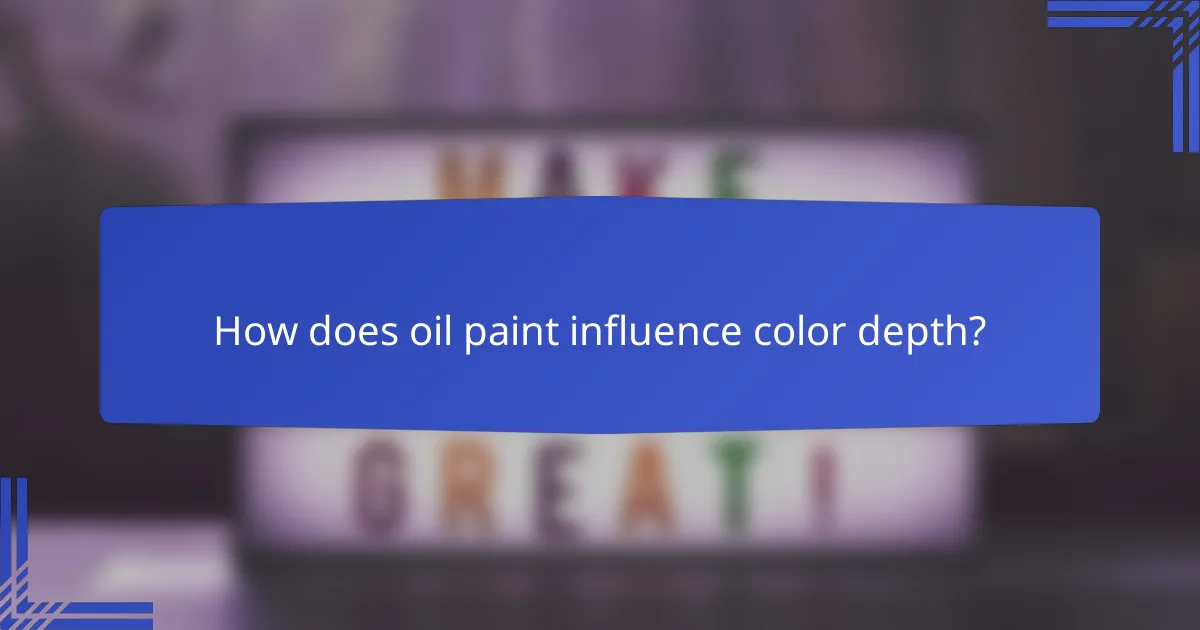
How does oil paint influence color depth?
Oil paint significantly enhances color depth due to its unique properties, including its ability to create rich, vibrant hues and subtle tonal variations. The slow drying time allows for extensive blending and layering, resulting in a more dynamic visual experience.
Color mixing for depth
Mixing colors in oil paint can create a greater sense of depth by allowing artists to achieve a wide range of shades and tones. When combining colors, consider using a limited palette to maintain harmony while exploring variations. For instance, mixing complementary colors can produce muted tones that add complexity to the overall composition.
To deepen colors, start with a base hue and gradually add small amounts of darker shades or complementary colors. This technique can enhance the richness and dimensionality of the artwork, making it visually engaging.
Layering techniques for vibrancy
Layering is a crucial technique in oil painting that contributes to vibrancy and depth. By applying multiple thin layers of paint, artists can create luminosity and a sense of three-dimensionality. Each layer should be allowed to dry partially before adding the next, which can take days to weeks depending on the thickness and environmental conditions.
Consider using the “fat over lean” rule, where each successive layer contains more oil than the previous one. This approach helps prevent cracking and ensures a stable finish while enhancing the vibrancy of the colors.
Impact of mediums on color
Mediums can significantly alter the properties of oil paint, affecting both drying time and color depth. For example, adding linseed oil can increase gloss and transparency, while using a medium like turpentine can enhance fluidity and drying speed. Each medium can influence how colors appear when layered, so choose wisely based on the desired effect.
Experimenting with different mediums can yield varied results; for instance, a slow-drying medium allows for more blending, while a fast-drying medium can create sharper edges. Understanding these impacts will help you achieve the color depth you aim for in your artwork.
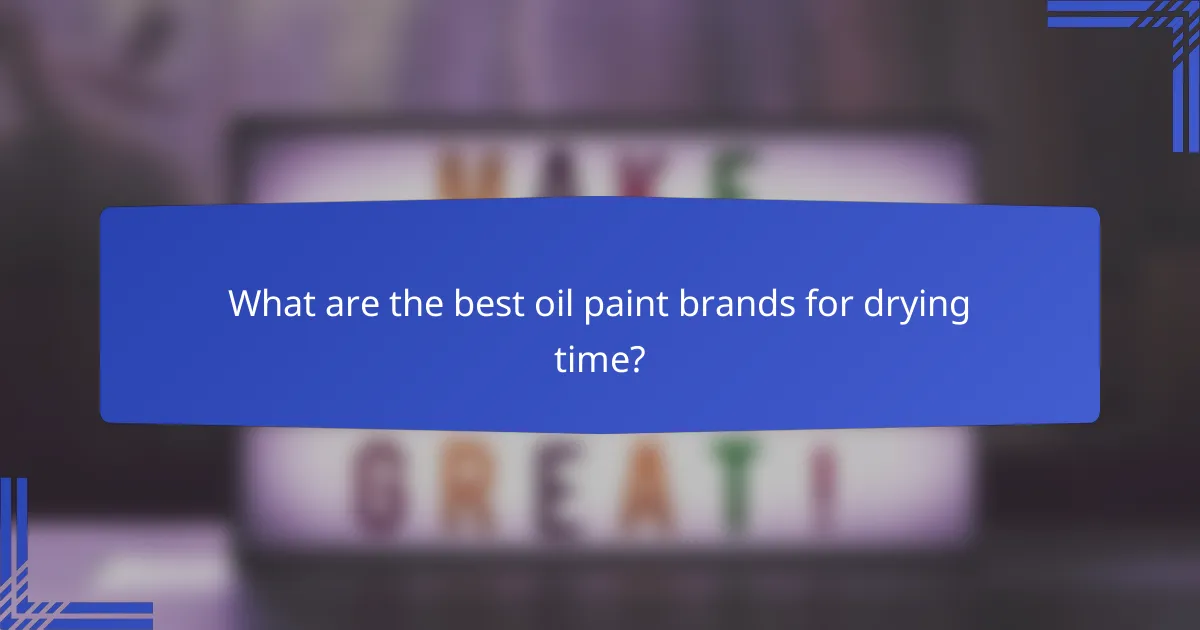
What are the best oil paint brands for drying time?
The best oil paint brands for drying time are those that offer a balance between quick drying and maintaining rich texture and color depth. Brands like Winsor & Newton, Gamblin, and Michael Harding are known for their reliable drying times, making them popular choices among artists.
Winsor & Newton
Winsor & Newton oil paints are recognized for their consistent quality and relatively fast drying times. Their professional line typically dries within a few days, which is advantageous for artists looking to layer quickly without compromising the paint’s integrity.
When using Winsor & Newton, consider their fast-drying mediums to further enhance drying speed. However, be cautious not to overuse these mediums, as they can alter the paint’s texture and finish.
Gamblin
Gamblin oil paints are favored for their high pigment load and excellent drying properties. Many of their colors dry within a week, allowing for efficient layering and blending. Gamblin also offers a line of fast-drying oils that can reduce drying time significantly.
Artists should note that while Gamblin paints dry relatively quickly, they still provide a rich texture and depth. Using their mediums can help achieve desired drying times without sacrificing quality.
Michael Harding
Michael Harding oil paints are known for their luxurious texture and vibrant colors, with drying times that range from a few days to a week. The brand emphasizes traditional methods, which can result in slower drying compared to some modern alternatives.
For artists who prefer a longer working time, Michael Harding paints are ideal. However, if quicker drying is needed, consider using their fast-drying mediums, which can help speed up the process while maintaining the paint’s rich qualities.
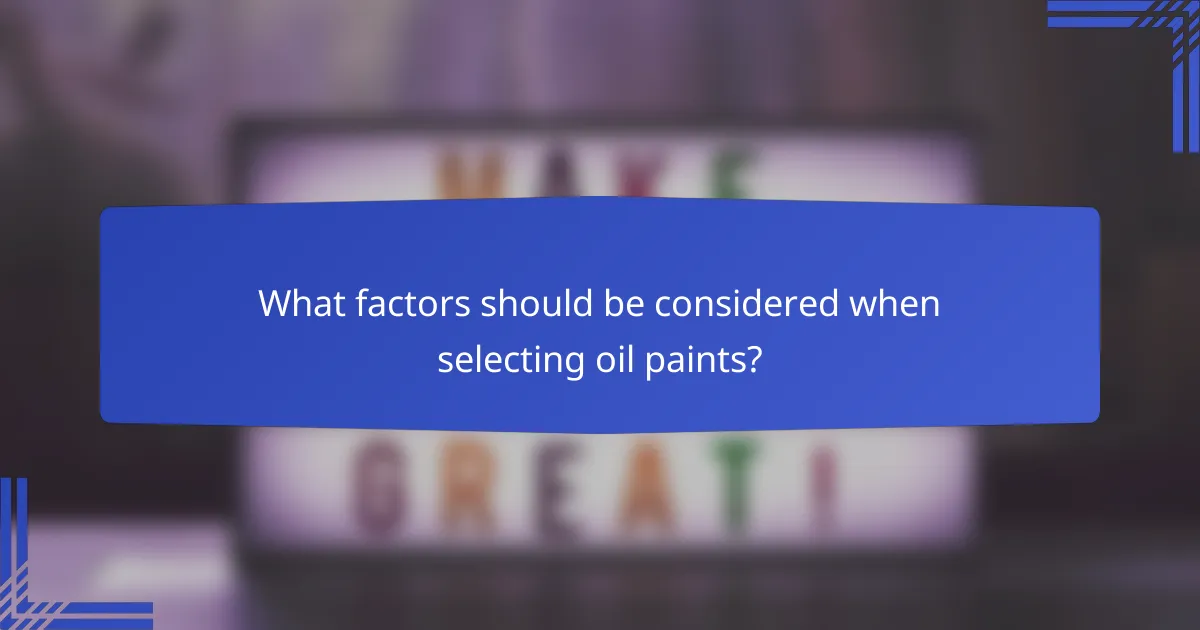
What factors should be considered when selecting oil paints?
When selecting oil paints, consider viscosity and texture, as well as the color range and pigment quality. These factors significantly influence the application, drying time, and overall finish of your artwork.
Viscosity and texture
Viscosity refers to the thickness of the paint, which affects how it flows and adheres to the canvas. Higher viscosity paints create more texture and can hold brush strokes, while lower viscosity paints are smoother and easier to blend.
When choosing oil paints, think about the desired texture in your artwork. For instance, if you want to create impasto effects, opt for thicker paints. Conversely, if you prefer a smooth finish, select paints with a lower viscosity.
Color range and pigment quality
The color range of oil paints varies widely, influenced by the pigments used. High-quality pigments provide richer, more vibrant colors and better lightfastness, meaning they resist fading over time.
When selecting colors, consider both the hue and the transparency of the pigments. Opaque colors can cover underlying layers effectively, while transparent colors are ideal for glazing techniques. Always check the pigment information on the label to ensure you are getting the quality you need for your projects.

How do environmental conditions affect oil paint drying?
Environmental conditions significantly influence the drying time of oil paint. Factors such as humidity and temperature can alter how quickly the paint sets and its final texture and color depth.
Humidity’s impact on drying
Humidity affects oil paint drying by influencing the evaporation rate of solvents. High humidity levels can slow down the drying process, leading to a longer wait time before the paint feels dry to the touch.
In contrast, low humidity can accelerate drying, sometimes causing the paint to dry too quickly, which may result in a less desirable texture. Artists often aim for moderate humidity, ideally between 40% and 60%, for optimal drying conditions.
Temperature effects on consistency
Temperature plays a crucial role in the consistency and drying time of oil paint. Warmer temperatures generally speed up the drying process, allowing the paint to set more quickly. However, excessive heat can lead to a thick, tacky texture that is difficult to work with.
Conversely, cooler temperatures can slow down drying significantly, which may be beneficial for blending techniques but can prolong the overall painting process. A comfortable working temperature of around 20°C to 25°C (68°F to 77°F) is often recommended for best results.
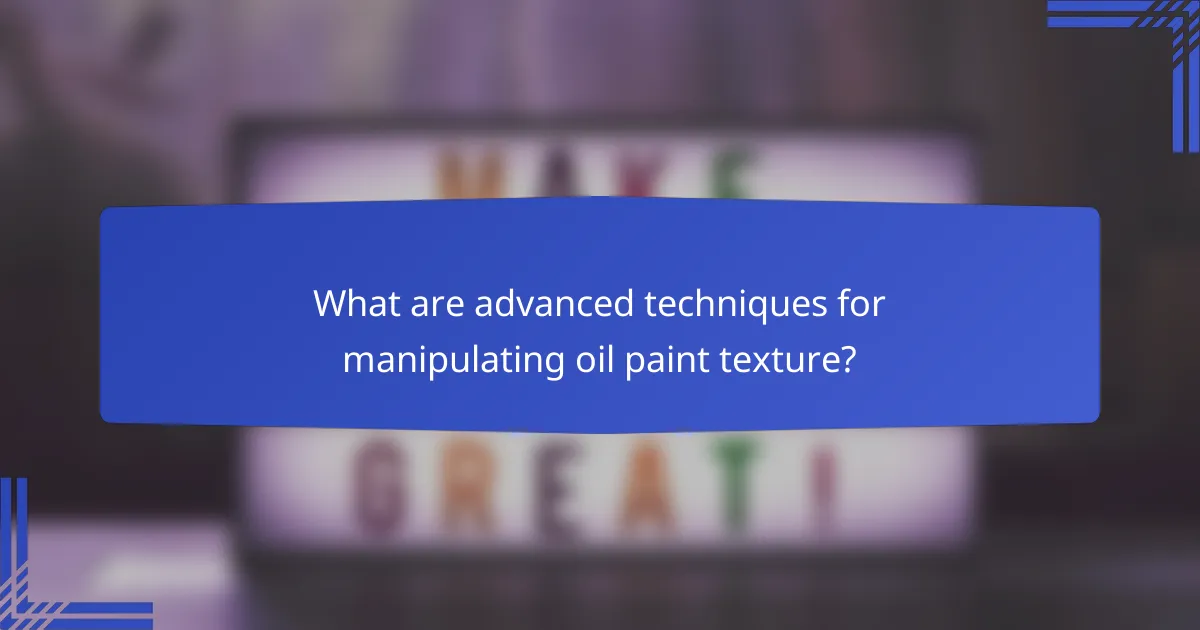
What are advanced techniques for manipulating oil paint texture?
Advanced techniques for manipulating oil paint texture involve using various tools and methods to create unique surface effects. Artists can achieve different textures by applying paint with palette knives, brushes, or even unconventional items, enhancing the visual depth and interest of their work.
Using palette knives for texture
Palette knives are versatile tools that allow artists to create a range of textures in oil paint. By applying paint with a knife instead of a brush, you can achieve thick, impasto effects or smooth, blended areas depending on the technique used.
To create texture, load the palette knife with paint and apply it directly to the canvas in various ways. You can scrape, spread, or layer the paint to form peaks and ridges. Experimenting with different knife shapes can yield diverse results, from sharp lines to soft curves.
Common pitfalls include overworking the paint, which can lead to a muddy appearance. It’s advisable to work in layers, allowing each to dry slightly before adding more, to maintain clarity and vibrancy in your textures.
